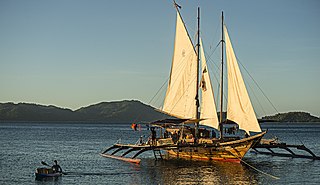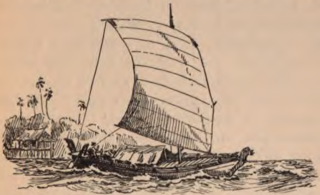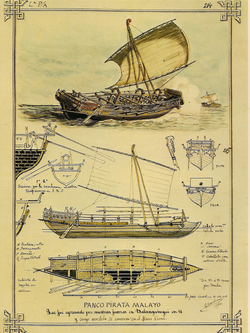
Outrigger boats are various watercraft featuring one or more lateral support floats known as outriggers, which are fastened to one or both sides of the main hull. They can range from small dugout canoes to large plank-built vessels. Outrigger boats can also vary in their configuration, from the ancestral double-hull configuration (catamarans), to single-outrigger vessels prevalent in the Pacific Islands and Madagascar, to the double-outrigger vessels (trimarans) prevalent in Island Southeast Asia. They are traditionally fitted with Austronesian sails, like the crab claw sails and tanja sails, but in modern times are often fitted with petrol engines.

Banguingui is a distinct ethnolinguistic group native to Balanguingui Island but also dispersed throughout the Sulu Archipelago and southern and western coastal regions of the Zamboanga Peninsula in Mindanao, Philippines.

A kora-kora or kora kora or coracora is a traditional canoe from the Maluku (Moluccas) Islands, Indonesia. They are naval boat for carrying men on raids for plunder or for slaves. In Maritime Southeast Asia, raiding for slaves was an honourable way of making a living, and the kora kora was needed for defence against raids as well as for forays. Large kora-kora is called juanga or joanga.

A balangay, or barangay, is a type of lashed-lug boat built by joining planks edge-to-edge using pins, dowels, and fiber lashings. They are found throughout the Philippines and were used largely as trading ships up until the colonial era. The oldest known balangay are the eleven Butuan boats, which have been carbon-dated individually from 689 to 988 CE and were recovered from several sites in Butuan, Agusan del Norte. The Butuan boats are the single largest concentration of lashed-lug boat remains of the Austronesian boatbuilding traditions. They are found in association with large amounts of trade goods from East Asia, Southeast Asia, and as far as Persia, indicating they traded as far as the Middle East.

The Sulu and Celebes Seas, a semi-enclosed sea area and porous region that covers an area of space around 1 million square kilometres, have been subject to illegal maritime activities since the pre-colonial era and continue to pose a maritime security threat to bordering nations up to this day. While piracy has long been identified as an ubiquitous challenge, being historically interwoven with the region, recent incidents also include other types of maritime crimes such as kidnapping and the trafficking of humans, arms and drugs. Attacks mostly classify as 'armed robbery against ships' according to the United Nations Convention on the Law of the Sea as they occur in maritime zones that lie under the sovereignty of a coastal state. Incidents in the Sulu and Celebes Seas specifically involve the abduction of crew members. Since March 2016, the Information Sharing Centre (ISC) of the Regional Cooperation Agreement on Combating Piracy and Armed Robbery against Ships in Asia (ReCAAP) reports a total of 86 abductions, leading to the issue of a warning for ships transpassing the area.

Karakoa were large outrigger warships from the Philippines. They were used by native Filipinos, notably the Kapampangans and the Visayans, during seasonal sea raids. Karakoa were distinct from other traditional Philippine sailing vessels in that they were equipped with platforms for transporting warriors and for fighting at sea. During peacetime, they were also used as trading ships. Large karakoa, which could carry hundreds of rowers and warriors, were known as joangas by the Spanish.
Joanga or juanga is Spanish for "junk". It can also refer to other large native ships in Southeast Asia, including:

Lanong were large outrigger warships used by the Iranun and the Banguingui people of the Philippines. They could reach up to 30 m (98 ft) in length and had two biped shear masts which doubled as boarding ladders. They also had one to three banks of oars rowed by galley slaves. They were specialized for naval battles. They were prominently used for piracy and slave raids from the mid-18th century to the early 19th century in most of Southeast Asia. The name lanong is derived from Lanun, an exonym of the Iranun people.

Penjajap, also pangajava and pangayaw, were native galley-like warships used by several Austronesian ethnic groups in maritime Southeast Asia. They were typically very long and narrow, and were very fast. They are mentioned as being used by native fleets in Indonesia, the southern Philippines, Malaysia, and Brunei.

Salisipan are long and narrow war canoes, with or without outriggers, of the Iranun and Banguingui people of the Philippines. They were mainly used for piracy and for raids on coastal areas. Salisipan resemble a long and narrow bangka that sit low on the water. They are propelled by rowers, steered by an oar at the stern, and are light enough to be hauled ashore. They are typically equipped with woven shields of nipa that could be propped along the sides to protect the rowers against arrows. They are sometimes also known by the more general terms vinta, baroto, or kakap. Salisipan are auxiliary vessels that accompany larger motherships like pangajava, garay, and lanong. Their presence was usually indicative of a larger raiding fleet nearby.

A lancaran or lanchara is a type of sailing ship used in Maritime Southeast Asia. Although similar in shape to Mediterranean galleys, the lancaran was the backbone of the regional fleet of the western half of Nusantara before Mediterranean influence came. For their war fleet, the Malays prefer to use shallow draught, oared longships similar to the galley, such as lancaran, penjajap, and kelulus. This is very different from the Javanese who prefer long-range, deep-draught round ships such as jong and malangbang. The reason for this difference is that the Malays operated their ships in riverine water, sheltered straits zone, and archipelagic environment, while the Javanese are often active in the open and high sea. After contact with Iberian people, both the Javanese and Malay fleets began to use the ghurab and ghali more frequently.

Tanja sail or tanja rig is a type of sail commonly used by the Austronesian people, particularly in Maritime Southeast Asia. It is also known as the tilted square sail, canted rectangular sail, rectangular balance lug, or balance lug sail in English. In historical sources, a tanja sail is sometimes incorrectly referred to as a lateen sail or simply square sail.

Bangka are various native watercraft of the Philippines. It originally referred to small double-outrigger dugout canoes used in rivers and shallow coastal waters, but since the 18th century, it has expanded to include larger lashed-lug ships, with or without outriggers. Though the term used is the same throughout the Philippines, "bangka" can refer to a very diverse range of boats specific to different regions. Bangka was also spelled as banca, panca, or panga in Spanish. It is also known archaically as sakayan.

Padewakangs were traditional boats used by the Bugis, Mandar, and Makassar people of South Sulawesi. Padewakangs were used for long-distance voyages serving the south Sulawesi kingdoms.

Kelulus or kalulus is a type of rowing boat used in the Nusantara archipelago. It is typically small in size and propelled using oar or paddle. However, for long-distance voyages, this boat can be equipped with sails. It is not the same as prahu kalulis of the eastern part of the Indonesian archipelago.

Palari is a type of Indonesian sailing vessel from South Sulawesi. It was mainly used by the people of Ara and Lemo Lemo, for transporting goods and people. This vessel is rigged with pinisi rig, which often makes it better known as "Pinisi" instead of its name. In Singapore, palari is known as "Makassartrader".

A kakap is a narrow river or coastal boat used for fishing in Malaysia, Indonesia, and Brunei. They are also sometimes used as auxiliary vessels to larger warships for piracy and coastal raids.

Bangkong is the war boat of dayak people, notably used by sea dayaks of Indonesia, Malaysia and Brunei. They are used for riverine warfare in Borneo, but they are also capable of sailing across the sea.

A juanga or joanga refers to large-sized kora-kora, karakoa and lanong. They are used all throughout the Philippines and Eastern Indonesia, in Maluku smaller versions were popular and are still used to this day (Kora-kora). They are propelled by oars but are not used for carrying cargo.

Austronesian vessels are the traditional seafaring vessels of the Austronesian peoples of Taiwan, Maritime Southeast Asia, Micronesia, coastal New Guinea, Island Melanesia, Polynesia, and Madagascar. They also include indigenous ethnic minorities in Vietnam, Cambodia, Myanmar, Thailand, Hainan, the Comoros, and the Torres Strait Islands.



























